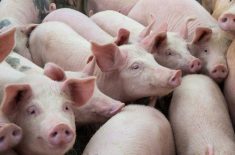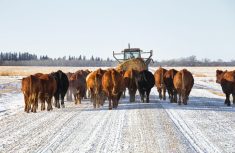Feeder cattle prices in Western Canada were steady to $2 higher last week; U.S. prices were $1 to $3 higher on average. Despite the U.S. Memorial Day holiday, the market was fairly solid as U.S. fed cattle sold for $1 to $2 higher. Gains in the slaughter market were transferred immediately into the feeder complex and with tighter available supplies, one could easily make the case for the higher price structure.
Canadian May feeder cattle exports to the U.S. are expected to finish near 40,000 head, which is abnormally high for this time of year. The softer Canadian dollar contributed to the export program but the stronger export pace is largely due to favourable U.S. feedlot margins.
Read Also

U.S. livestock: ‘Cattle on feed’ report supports prices
Chicago cattle futures rose as the USDA’s ‘Cattle on Feed’ report showed inventories two per cent down from a year…
All cattle markets seemed to shrug off the slide in the equity and energy markets last week. Beef wholesale prices dropped to the lowest levels since March as retailers and restaurants tempered forward purchases. After strong consumer sales in January through March, the average person appears to be taking a second look at his or her financial capability to go out for dinner on a regular basis. Restaurants have been gearing up from higher traffic during the summer but this may be presumptuous as the Dow Jones closed below the psychological 10,000 level.
Despite the weaker feeder cattle futures, cash prices have stayed relatively strong over the past month. More recently, we have seen strength in the 6-weight and 7-weight categories. Feed grain prices remain under pressure, which has helped sustain the feeder market. Canadian feedlots are moving larger numbers of fed cattle and continue shopping for replacements after cleaning up empty pens. Despite all the negative economic news, there is still a fair amount of optimism for the third and fourth quarters of 2010. Feedlots appear to be comfortable taking on the margin risk despite the weaker fed cattle futures.
— Jerry Klassen is a commodity market analyst in Winnipeg and maintains an interest in the family feedlot in southern Alberta. He writes an in-depth biweekly commentary, Canadian Feedlot and Cattle Market Analysis, for feedlot operators in Western Canada. He can be reached by email at [email protected] or 204-287-8268 for questions or comments.
The material contained herein is for information purposes only and is not to be construed as an offer for the sale or purchase of securities, options and/or futures or futures options contracts. While the information in this publication cannot be guaranteed, it was obtained from sources believed to be reliable. The risk of loss in futures trading can be substantial. The article is an opinion only and may not be accurate about market direction in the future. Do not use this information to make buying or selling decision because adverse consequences may occur. This information may be wrong and may not be correct about current market conditions in all areas of Canada. This is an opinion only and not based on verified facts.
Table 1. Feeder steers (US$ per hundredweight)
| Weight | Alta. | Alta. | Sask. | Sask. | Man. | Man. |
| (lbs.) | June 4 | May 7 | June 4 | May 7 | June 4 | May 7 |
| 500-600 | 115 | 122 | 114 | 119 | 113 | 119 |
| 600-700 | 109 | 114 | 105 | 114 | 108 | 111 |
| 700-800 | 102 | 105 | 100 | 105 | 100 | 103 |















